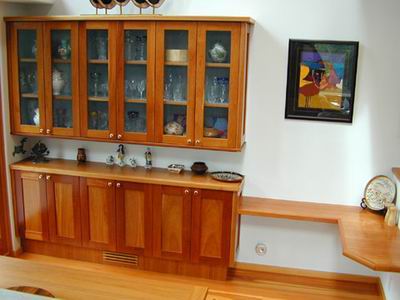Question
I've seen a couple of SCMI/Sandya machines come on the market after just a couple of years in operation. They have a single motor driving both sanding heads. Some of the newer Far East machines have this same configuration. I'm going to be in the market for a 2-head machine next year. My existing electric service in my leased space is just 200 A, so a machine like this is tempting. But will the single motor limit performance?
Right now I don't hog off much on the sander, just use it to take off .01" to .02" per pass. We sand planed door panels and finished doors/drawer faces only - we use a planer with shelix head for thicknessing. So are these low hour machines a good option, considering the workload, or will it be a limit later on?
Forum Responses
(Cabinetmaking Forum)
From contributor M:
My 2 head sander has a single motor, just as you described, driving both heads and it has never been a problem. For the right price, I'd say go for it.
Typically, for your application (doors and door components), you will be calibrating with 80 or 100 grit paper on a 90 shore (hardness) rubber coated drum. Steel drums (not recommended for your application) should only be used with paper below 80 grit, and they are notorious for leaving chatter marks.
You typically need 15 to 25 Hp for the first head, depending on the head type, head width and grit.
The second (and third) head(s) are mainly used to remove the scratches from the calibrating head. These heads should have drums with progressively larger diameters and softer rubber coatings, in order for the finer grits to work effectively. (Think of how you hand sand - a hard block with coarse grits and a cork covered block with finer grits). These heads use considerably less power than the first head.
For a two head 43" wide sander, you probably want a 30 Hp motor or a 20Hp + 15Hp (if a two motor machine). You can get a one pass sander (for doors) with a machine that has 3 heads and two motors (25Hp + 20Hp). This will typically payoff much faster than a two head machine when you look at the amount of time spent making two passes and changing belts on the two head sander.
More questions: What grit do you typically platen sand to for door finishing?
Aside from premature wear of belts, which is a cost issue, is there a quality downside to running a 2 head sander with finer grits to get a single pass finish?
How long do abrasive belts last on your grit sequence? Cost per year?
SCMI and SAC are both good Italian sanders, and I would buy one of those before an Asian import. Setup is crucial on a multi-head sander. All you want that second head doing is taking out the scratch marks from the first belt and not any more, otherwise you're wearing it out prematurely and driving up your abrasives costs.
A good source of reading material on the subject can be found in the archives of Modern Woodworking and the Sanding Sense articles written by Howard Grivna. He also has a book for sale that covers all that. If you do decide to go the widebelt route, by all means study it, as he covers rates of removal and setup as well as many other topics you'll need to be versed in to run a widebelt effectively.
